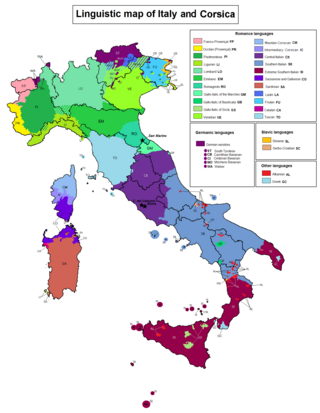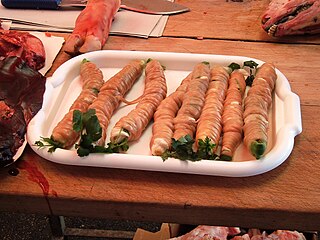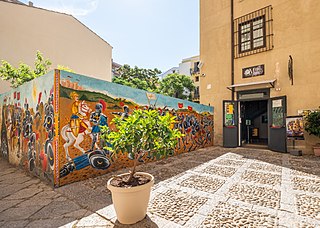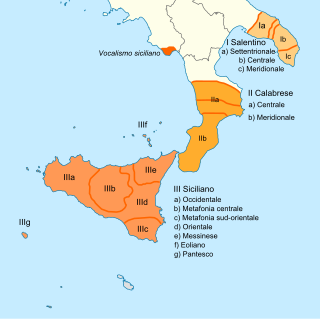Related Research Articles

Sicilian is a Romance language that is spoken on the island of Sicily and its satellite islands. It belongs to the broader Extreme Southern Italian language group.
Gerhard Rohlfs was a German linguist. He taught Romance languages and literature at the universities of Tübingen and Munich. He was described as an "archeologist of words".

The muffuletta or muffaletta is a type of round Sicilian sesame bread and a popular sandwich that originated among Italian immigrants in New Orleans, Louisiana, using the same bread.
The primary languages of Calabria are the Italian language as well as regional varieties of Extreme Southern Italian and Neapolitan languages, all collectively known as Calabrian. In addition, there are speakers of the Arbëresh variety of Albanian, as well as Calabrian Greek speakers and pockets of Occitan.
Arba Sicula is a not-for-profit international society whose main objective is the preservation and promotion of the Sicilian language and culture. Its administration is located in Mineola, New York. The majority of members are also from the United States, although there are also members from Sicily, Canada and other countries where Sicilian immigrants are found in large numbers. The society was founded in 1978.

Antonio Veneziano was an Italian poet who wrote mainly in the Sicilian language. He is considered among the greatest poets who wrote in Sicilian, which include Giovanni Meli, Domenico Tempio and Nino Martoglio. He is perhaps the first major figure in Sicilian literature following the Sicilian School which predates him by three centuries. During his lifetime, he was well known for his poetry both within Sicily and far beyond. He also wrote in Italian and Latin.

Gallo-Italic of Sicily is a group of Gallo-Italic languages found in about 15 isolated communities of central eastern Sicily. Forming a language island in the otherwise Sicilian language area, it dates back to migrations from northern Italy during the reign of Norman Roger I of Sicily and his successors.

Salentino is a dialect of the Extreme Southern Italian spoken in the Salento peninsula, which is the southern part of the region of Apulia at the southern "heel" of the Italian peninsula.
The Centro di studi filologici e linguistici siciliani is a non-profit organization which aims to promote the studies of ancient and modern Sicilian. Founded in 1951, it has its seat at the University of Palermo and is placed under the patronage of the President of the Sicilian Region and the Rectors of the Sicilian universities. During its history, the Center has published copious amounts of reference materials regarding the Sicilian language.

Lu rebellamentu di Sichilia, fully Cronica di lu rebellamentu di Sichilia contra re Carlu, is a Sicilian historical chronicle of the War of the Vespers written around 1290. The anonymous Rebellamentu, probably written at Messina, was ascribed to Atanasiu di Iaci by Pasquale Castorina in 1883. Though the Rebellamentu sometimes adds valuable details to the history of the Vespers, it is frequently untrustworthy. Its monastic provenance is evident in its moralising tone. The antiquity of its language has placed its authenticity beyond doubt, despite its lack of an early manuscript tradition. This has not prevented speculation that it was written contemporarily with events: one verb in one manuscript is found in the first-person present; this may represent the author inadvertently stepping out of his usual frame of reference, or merely an error in that manuscript.

Frate Atanasiu di Iaci or Athanasiu da Jaci was a Benedictine monk and historiographer from Aci. He wrote Vinuta di lu re Japicu in Catania (c.1295), a Sicilian chronicle of the arrival and stay of James I in Catania in May 1287. He may also be the author of another Sicilian history, Lu rebellamentu di Sichilia, written circa 1290, by an anonymous person of Messina. Vincenzo di Giovanni suggested that Atanasiu was of Saracen ancestry.

In Italy, there are some active movements and parties calling for autonomy or even independence for the areas comprised within the historical Kingdom of the two Sicilies: that is, Southern Italy and/or the region of Sicily. No political movement promoting these ideas has ever been successful in gaining traction among the population. The movement remains on the fringes with no representation in the Italian parliament.

The Opera dei Pupi is a marionette theatrical representation of Frankish romantic poems traditionally performed in Sicily, Italy.
Gaetano Cipolla is a retired professor of Italian and Chairman of the Department of Modern Foreign Languages at St. John's University in New York City. He was born and raised in Francavilla di Sicilia in Messina Province, Sicily and emigrated to the US in 1955. He received his Bachelor of Science (1961) from New York University, Master of Arts (1969) from Hunter College (CUNY), and the PhD (1974) from New York University. He joined the faculty of St. John's University in 1974 and retired in 2011.

The stigghiola is a Sicilian food specialty, typical of the streets of the city of Palermo. It consists of guts which are washed in water and salt, seasoned with parsley and often with onion and other pot herbs, then stuck on a skewer or rolled around a leek, and finally cooked directly on the grill. The dish is generally prepared and sold as a street food. In Ragusa, the dish is baked in a casserole and it is known as turciniuna.
Henri Bresc is a French historian who specialises in the Mediaeval history of Sicily, and particularly in the inter-relation in the Mediterranean area between the three principal monotheistic religions. From 1990 until 2008 he was a professor at Paris X Nanterre university, and is director of its Centre d'Histoire Sociale et Culturelle de l'Occident. He previously taught at the University of Nice.
Mario Fasino was an Italian politician, journalist, and one of the co-founders of Christian Democratic Party (DC) in Sicily. He served as the President of the region of Sicily from 20 September 1969 until 22 December 1972. Fasino was elected President of the Sicilian Regional Assembly from 1974 to 1976. In addition to his political career, Fasino, a journalist, was the director of "Voce cattolica", the official publication of the Roman Catholic Archdiocese of Palermo.

Cademia Siciliana is a transnational non-profit organization founded in 2016 by a group of Sicilian language academics, activists, researchers, and students with the mission to promote the Sicilian language through education, research, and activism. The organization has published an orthographical proposal for the Sicilian language, and maintains several Sicilian language research and technology projects. Including translation and language advocacy projects for several popular applications and platforms such as Firefox, Telegram, Facebook and Android Keyboard. In 2021 the group gained attention for their collaboration with Google's Woolaroo, an augmented reality project intended to support regional and minority languages.

The Antonio Pasqualino International Puppet Museum of Palermo operates in the field of national and international, traditional and contemporary puppetry.

The Extreme Southern Italian dialects are a set of languages spoken in Salento, Calabria, Sicily and southern Cilento with common phonetic and syntactic characteristics such as to constitute a single group. These languages derive, without exception, from vulgar Latin and not from Tuscan; therefore it follows that the name "Italian" is a purely geographical reference.
References
- 1 2 Cipolla, Gaetano (2005). The Sound of Sicilian: A Pronunciation Guide. New York City: Legas. ISBN 978-1-881901-51-8.
- 1 2 Camilleri, Salvatore (1998). Vocabolario Italiano Siciliano (in Italian and Sicilian). Catania: Edizioni Greco. ISBN 9788875122881.
- ↑ Vigo, Lionardo (1857). Opere (in Italian). Tipografia Galatola. p. 99.
Lionardo Vigo .
- ↑ Meli, Giovanni (1814). Poesie siciliane dell'abate Giovanni Meli (in Sicilian). Interollo.
- 1 2 Piccitto, Giorgio (1997). Vocabolario siciliano (in Italian). Centro di studi filologici e linguistici siciliani, Opera del Vocabolario siciliano.
- ↑ Matranga, Vito (2007). Trascrivere. La rappresentazione del parlato nell'esperienza dell'Atlante Linguistico della Sicilia (in Italian). Palermo: Centro di studi filologici e linguistici siciliani.
- ↑ Cipolla, Gaetano (2013). Learn Sicilian. Legas. ISBN 978-1-881901-89-1.
- ↑ Wdowiak, Eryk (2021-09-27). "Sicilian Translator: A Recipe for Low-Resource NMT". arXiv: 2110.01938 [cs.CL].
- 1 2 Cadèmia Siciliana (2017). "Proposta di normalizzazione ortografica comune della lingua siciliana" (PDF) (in Italian) (2017 ed.).